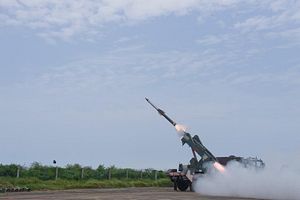On Sunday, India conducted a test-launch of the Quick Reaction Surface-to-Air Missile (QRASM), an indigenous system. The test, which was conducted from a launch site in the eastern Indian state of Odisha, was a success, according to the Indian Defense Research and Development Organization (DRDO).
“The air defense system, QRSAM, was test-fired at 11.05 a.m. from a mobile truck-based launch unit at complex 3 of the Integrated Test Range (ITR) at Chandipur near here,” a Press Trust of India report citing DRDO sources noted.
The missile is designed for canisterized storage aboard a transporter-erector-launcher vehicle. It has a range of 30 kilometers and use solid rocket propellant. The QRASM entered testing two years ago, with its first test taking place on June 4, 2017. A December 2017 test of the QRSAM failed.
Earlier this year, DRDO oversaw two more tests of the QRASM on February 26. Those tests coincided with the Indian Air Force’s strikes at the Pakistani town of Balakot in retaliation for a militant attack against Indian paramilitary forces in Kashmir by a Pakistan-based group earlier in the month.
QRSAM missiles are manufactured by Bharat Electronics Limited and Bharat Dynamics Limited and are intended for use by the Indian Army. The missiles are meant to succeed the Indian Army’s Soviet-sourced SA-8 and SA-6 SAMs.
In 2017, the Indian Ministry of Defense, to support Indian Prime Minister Narendra Modi’s “Make in India” initiative, decided to set aside plans to procure a new SAM system from overseas, opting to proceed with DRDO’s QRSAM design instead.
Aside from the QRSAM and India’s older Soviet SAMs, the Indian Army and Indian Air Force currently operate the Akash surface-to-air missile, which covers aerial targets at altitudes up to 18 kilometers at ranges up to 30 kilometers.
The Akash was inducted into the Indian Army in 2015 and is reported to be under consideration for export customers.
DRDO is also developing the Maitri, a quick-reaction surface-to-air missile. Moreover, India and Israel have jointly developed the Barak 8, a longer-range surface-to-air system that may have a range of up to 100 kilometers. Israel Aerospace Industries (IAI) and India’s DRDO collaborated on the Barak 8.
The Indian Air Force also operates the Israeli SPYDER QRSAM system, which is capable of launching Python-5 and Derby missiles as its interceptors. The Python-5 is a highly maneuverable missile, featuring “lock-on after launch” capabilities. The Derby features active radar homing and is an improved version of the Python-4. Both missiles are beyond-visual-range capable.































